The Best Ornamental Grasses
Ornamental grasses require little maintenance and add color and interesting texture to any garden. Which types of ornamental grasses to choose? Pick one appropriate for your hardiness zone and climate. Here are seven of our favorites.
1. Muhly grass (Muhlbergia capillaris)
This beautiful and showy ornamental grass grows to 3 feet (90 cm) in either direction in a sunny location in USDA hardiness zones 6–11. Growing muhly grass is easiest in warm locations. It has showy pink flowers in the fall that create a real show-stopping display with their fluffy, cloud-like texture.
2. Maiden grass (Miscanthus sinensus ‘Gracillimus’)
A popular ornamental grass for cooler hardiness zones. It thrives in USDA zones 5–9. This is a warm-season, clump-forming grass that can grow to 5 feet (152cm) and even taller. It is also called Chinese silvergrass, maiden grass is appreciated for its graceful arching form (its narrow leaves sway in the breeze) and coppery flower panicles in late summer that become silvery plumes. This ornamental grass from Green Promise Farms is beloved by birds and is destined to be your favorite, too.
3. Feather reed grass (Calamagrostis x acutiflora ‘Karl Foerster’)
An extremely showy and popular ornamental grass, feather reed grass has tall, narrow green leaves and grows in upright clumps. The flower spikes are light purple, and the golden seeds persist into the winter. Feather reed grass care is possible in all but the coldest regions, USDA zones 4-11, and requires a full sun location.
4. Lemongrass (Cymbopogon citratus)
For the warmest regions – USDA zones 10 and 11 – consider lemongrass, a relatively short, densely clumping grass native to India. The slender leaves of grass arch gently and tolerate poor soil. Growing lemongrass requires a location with partial or full sun.
5. Blue Fescue (Festuca ovina var. glauca)
This cool-season, clump-forming ornamental grass is native to Europe. It has extremely attractive silvery-blue foliage and only grows to 10 inches (25cm) tall growth. Blue fescue growing is best in a full sun location although it will grow in partial sun. If you want the blue shade deeper, give the grass more sun and pick a cultivar like Elijah Blue. Grow your own lemongrass to kick up your culinary game and your flower beds.
6. Purple Fountain Grass (Pennisetum setaceum ‘Rubrum’)
Purple fountain grass is a warm-season, clump forming grass native to Africa that likes a full sun location. Its thin leaves grow to 4 feet (121 cm) tall in a graceful, arching habit. This variety is famed for its burgundy purple foliage. In mid- to late summer, it bears long dark purple flower spikes that resemble bottle brush and they persist until the first frost. This variety is for warm-winter climates only, thriving in USDA zones 8–11, but it’s possible to grow purple fountain grass as an annual in chillier regions.
7. Zebra grass (Miscanthus sinensis ‘Zebrinus’)
You really understand the term “ornamental” when you look at zebra grass (Miscanthus sinensis Zebrinus), with its blades of grass rising to 5 feet tall (152 cm). The green grass blades offer dramatic variegation with horizontal golden strips, and the golden section increases in early fall. For additional interest, the grass produces small white flowers followed by seed head plumes. Zebra grass care is recommended in USDA hardiness zones 7-9. This article features products available from third-party vendors on the Gardening Know How Shop.
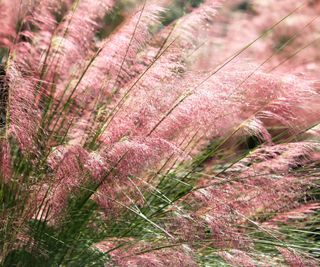
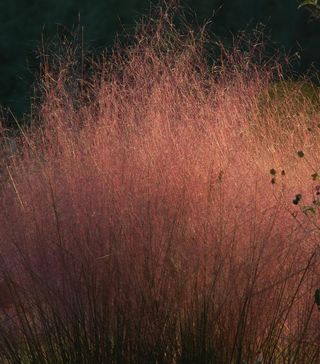
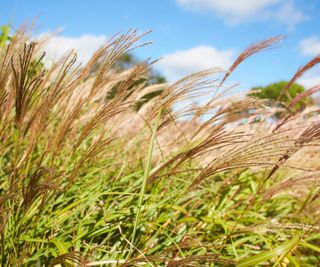
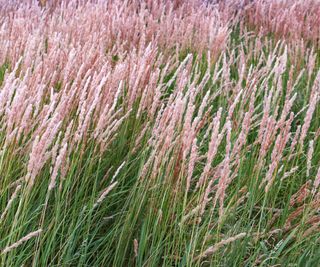
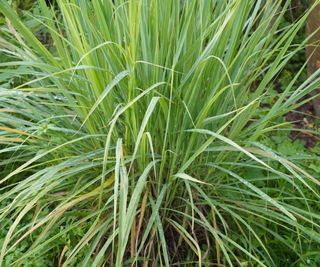
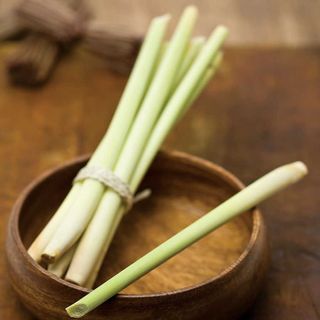
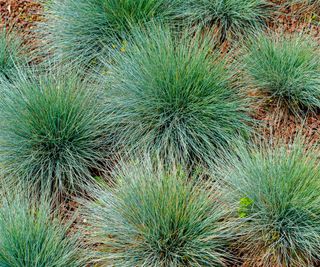
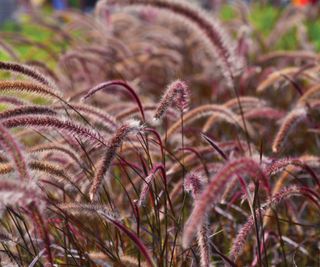
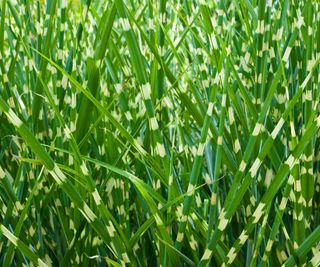
title: “7 Ornamental Grasses For Gorgeous Texture Soothing Sounds” ShowToc: true date: “2024-09-29” author: “Wilfredo Garbarino”
The Best Ornamental Grasses
Ornamental grasses require little maintenance and add color and interesting texture to any garden. Which types of ornamental grasses to choose? Pick one appropriate for your hardiness zone and climate. Here are seven of our favorites.
1. Muhly grass (Muhlbergia capillaris)
This beautiful and showy ornamental grass grows to 3 feet (90 cm) in either direction in a sunny location in USDA hardiness zones 6–11. Growing muhly grass is easiest in warm locations. It has showy pink flowers in the fall that create a real show-stopping display with their fluffy, cloud-like texture.
2. Maiden grass (Miscanthus sinensus ‘Gracillimus’)
A popular ornamental grass for cooler hardiness zones. It thrives in USDA zones 5–9. This is a warm-season, clump-forming grass that can grow to 5 feet (152cm) and even taller. It is also called Chinese silvergrass, maiden grass is appreciated for its graceful arching form (its narrow leaves sway in the breeze) and coppery flower panicles in late summer that become silvery plumes. This ornamental grass from Green Promise Farms is beloved by birds and is destined to be your favorite, too.
3. Feather reed grass (Calamagrostis x acutiflora ‘Karl Foerster’)
An extremely showy and popular ornamental grass, feather reed grass has tall, narrow green leaves and grows in upright clumps. The flower spikes are light purple, and the golden seeds persist into the winter. Feather reed grass care is possible in all but the coldest regions, USDA zones 4-11, and requires a full sun location.
4. Lemongrass (Cymbopogon citratus)
For the warmest regions – USDA zones 10 and 11 – consider lemongrass, a relatively short, densely clumping grass native to India. The slender leaves of grass arch gently and tolerate poor soil. Growing lemongrass requires a location with partial or full sun.
5. Blue Fescue (Festuca ovina var. glauca)
This cool-season, clump-forming ornamental grass is native to Europe. It has extremely attractive silvery-blue foliage and only grows to 10 inches (25cm) tall growth. Blue fescue growing is best in a full sun location although it will grow in partial sun. If you want the blue shade deeper, give the grass more sun and pick a cultivar like Elijah Blue. Grow your own lemongrass to kick up your culinary game and your flower beds.
6. Purple Fountain Grass (Pennisetum setaceum ‘Rubrum’)
Purple fountain grass is a warm-season, clump forming grass native to Africa that likes a full sun location. Its thin leaves grow to 4 feet (121 cm) tall in a graceful, arching habit. This variety is famed for its burgundy purple foliage. In mid- to late summer, it bears long dark purple flower spikes that resemble bottle brush and they persist until the first frost. This variety is for warm-winter climates only, thriving in USDA zones 8–11, but it’s possible to grow purple fountain grass as an annual in chillier regions.
7. Zebra grass (Miscanthus sinensis ‘Zebrinus’)
You really understand the term “ornamental” when you look at zebra grass (Miscanthus sinensis Zebrinus), with its blades of grass rising to 5 feet tall (152 cm). The green grass blades offer dramatic variegation with horizontal golden strips, and the golden section increases in early fall. For additional interest, the grass produces small white flowers followed by seed head plumes. Zebra grass care is recommended in USDA hardiness zones 7-9. This article features products available from third-party vendors on the Gardening Know How Shop.









title: “7 Ornamental Grasses For Gorgeous Texture Soothing Sounds” ShowToc: true date: “2024-09-26” author: “Neil Watts”
The Best Ornamental Grasses
Ornamental grasses require little maintenance and add color and interesting texture to any garden. Which types of ornamental grasses to choose? Pick one appropriate for your hardiness zone and climate. Here are seven of our favorites.
1. Muhly grass (Muhlbergia capillaris)
This beautiful and showy ornamental grass grows to 3 feet (90 cm) in either direction in a sunny location in USDA hardiness zones 6–11. Growing muhly grass is easiest in warm locations. It has showy pink flowers in the fall that create a real show-stopping display with their fluffy, cloud-like texture.
2. Maiden grass (Miscanthus sinensus ‘Gracillimus’)
A popular ornamental grass for cooler hardiness zones. It thrives in USDA zones 5–9. This is a warm-season, clump-forming grass that can grow to 5 feet (152cm) and even taller. It is also called Chinese silvergrass, maiden grass is appreciated for its graceful arching form (its narrow leaves sway in the breeze) and coppery flower panicles in late summer that become silvery plumes. This ornamental grass from Green Promise Farms is beloved by birds and is destined to be your favorite, too.
3. Feather reed grass (Calamagrostis x acutiflora ‘Karl Foerster’)
An extremely showy and popular ornamental grass, feather reed grass has tall, narrow green leaves and grows in upright clumps. The flower spikes are light purple, and the golden seeds persist into the winter. Feather reed grass care is possible in all but the coldest regions, USDA zones 4-11, and requires a full sun location.
4. Lemongrass (Cymbopogon citratus)
For the warmest regions – USDA zones 10 and 11 – consider lemongrass, a relatively short, densely clumping grass native to India. The slender leaves of grass arch gently and tolerate poor soil. Growing lemongrass requires a location with partial or full sun.
5. Blue Fescue (Festuca ovina var. glauca)
This cool-season, clump-forming ornamental grass is native to Europe. It has extremely attractive silvery-blue foliage and only grows to 10 inches (25cm) tall growth. Blue fescue growing is best in a full sun location although it will grow in partial sun. If you want the blue shade deeper, give the grass more sun and pick a cultivar like Elijah Blue. Grow your own lemongrass to kick up your culinary game and your flower beds.
6. Purple Fountain Grass (Pennisetum setaceum ‘Rubrum’)
Purple fountain grass is a warm-season, clump forming grass native to Africa that likes a full sun location. Its thin leaves grow to 4 feet (121 cm) tall in a graceful, arching habit. This variety is famed for its burgundy purple foliage. In mid- to late summer, it bears long dark purple flower spikes that resemble bottle brush and they persist until the first frost. This variety is for warm-winter climates only, thriving in USDA zones 8–11, but it’s possible to grow purple fountain grass as an annual in chillier regions.
7. Zebra grass (Miscanthus sinensis ‘Zebrinus’)
You really understand the term “ornamental” when you look at zebra grass (Miscanthus sinensis Zebrinus), with its blades of grass rising to 5 feet tall (152 cm). The green grass blades offer dramatic variegation with horizontal golden strips, and the golden section increases in early fall. For additional interest, the grass produces small white flowers followed by seed head plumes. Zebra grass care is recommended in USDA hardiness zones 7-9. This article features products available from third-party vendors on the Gardening Know How Shop.









title: “7 Ornamental Grasses For Gorgeous Texture Soothing Sounds” ShowToc: true date: “2024-09-28” author: “David Richmond”
The Best Ornamental Grasses
Ornamental grasses require little maintenance and add color and interesting texture to any garden. Which types of ornamental grasses to choose? Pick one appropriate for your hardiness zone and climate. Here are seven of our favorites.
1. Muhly grass (Muhlbergia capillaris)
This beautiful and showy ornamental grass grows to 3 feet (90 cm) in either direction in a sunny location in USDA hardiness zones 6–11. Growing muhly grass is easiest in warm locations. It has showy pink flowers in the fall that create a real show-stopping display with their fluffy, cloud-like texture.
2. Maiden grass (Miscanthus sinensus ‘Gracillimus’)
A popular ornamental grass for cooler hardiness zones. It thrives in USDA zones 5–9. This is a warm-season, clump-forming grass that can grow to 5 feet (152cm) and even taller. It is also called Chinese silvergrass, maiden grass is appreciated for its graceful arching form (its narrow leaves sway in the breeze) and coppery flower panicles in late summer that become silvery plumes. This ornamental grass from Green Promise Farms is beloved by birds and is destined to be your favorite, too.
3. Feather reed grass (Calamagrostis x acutiflora ‘Karl Foerster’)
An extremely showy and popular ornamental grass, feather reed grass has tall, narrow green leaves and grows in upright clumps. The flower spikes are light purple, and the golden seeds persist into the winter. Feather reed grass care is possible in all but the coldest regions, USDA zones 4-11, and requires a full sun location.
4. Lemongrass (Cymbopogon citratus)
For the warmest regions – USDA zones 10 and 11 – consider lemongrass, a relatively short, densely clumping grass native to India. The slender leaves of grass arch gently and tolerate poor soil. Growing lemongrass requires a location with partial or full sun.
5. Blue Fescue (Festuca ovina var. glauca)
This cool-season, clump-forming ornamental grass is native to Europe. It has extremely attractive silvery-blue foliage and only grows to 10 inches (25cm) tall growth. Blue fescue growing is best in a full sun location although it will grow in partial sun. If you want the blue shade deeper, give the grass more sun and pick a cultivar like Elijah Blue. Grow your own lemongrass to kick up your culinary game and your flower beds.
6. Purple Fountain Grass (Pennisetum setaceum ‘Rubrum’)
Purple fountain grass is a warm-season, clump forming grass native to Africa that likes a full sun location. Its thin leaves grow to 4 feet (121 cm) tall in a graceful, arching habit. This variety is famed for its burgundy purple foliage. In mid- to late summer, it bears long dark purple flower spikes that resemble bottle brush and they persist until the first frost. This variety is for warm-winter climates only, thriving in USDA zones 8–11, but it’s possible to grow purple fountain grass as an annual in chillier regions.
7. Zebra grass (Miscanthus sinensis ‘Zebrinus’)
You really understand the term “ornamental” when you look at zebra grass (Miscanthus sinensis Zebrinus), with its blades of grass rising to 5 feet tall (152 cm). The green grass blades offer dramatic variegation with horizontal golden strips, and the golden section increases in early fall. For additional interest, the grass produces small white flowers followed by seed head plumes. Zebra grass care is recommended in USDA hardiness zones 7-9. This article features products available from third-party vendors on the Gardening Know How Shop.









title: “7 Ornamental Grasses For Gorgeous Texture Soothing Sounds” ShowToc: true date: “2024-09-18” author: “Virgil Burroughs”
The Best Ornamental Grasses
Ornamental grasses require little maintenance and add color and interesting texture to any garden. Which types of ornamental grasses to choose? Pick one appropriate for your hardiness zone and climate. Here are seven of our favorites.
1. Muhly grass (Muhlbergia capillaris)
This beautiful and showy ornamental grass grows to 3 feet (90 cm) in either direction in a sunny location in USDA hardiness zones 6–11. Growing muhly grass is easiest in warm locations. It has showy pink flowers in the fall that create a real show-stopping display with their fluffy, cloud-like texture.
2. Maiden grass (Miscanthus sinensus ‘Gracillimus’)
A popular ornamental grass for cooler hardiness zones. It thrives in USDA zones 5–9. This is a warm-season, clump-forming grass that can grow to 5 feet (152cm) and even taller. It is also called Chinese silvergrass, maiden grass is appreciated for its graceful arching form (its narrow leaves sway in the breeze) and coppery flower panicles in late summer that become silvery plumes. This ornamental grass from Green Promise Farms is beloved by birds and is destined to be your favorite, too.
3. Feather reed grass (Calamagrostis x acutiflora ‘Karl Foerster’)
An extremely showy and popular ornamental grass, feather reed grass has tall, narrow green leaves and grows in upright clumps. The flower spikes are light purple, and the golden seeds persist into the winter. Feather reed grass care is possible in all but the coldest regions, USDA zones 4-11, and requires a full sun location.
4. Lemongrass (Cymbopogon citratus)
For the warmest regions – USDA zones 10 and 11 – consider lemongrass, a relatively short, densely clumping grass native to India. The slender leaves of grass arch gently and tolerate poor soil. Growing lemongrass requires a location with partial or full sun.
5. Blue Fescue (Festuca ovina var. glauca)
This cool-season, clump-forming ornamental grass is native to Europe. It has extremely attractive silvery-blue foliage and only grows to 10 inches (25cm) tall growth. Blue fescue growing is best in a full sun location although it will grow in partial sun. If you want the blue shade deeper, give the grass more sun and pick a cultivar like Elijah Blue. Grow your own lemongrass to kick up your culinary game and your flower beds.
6. Purple Fountain Grass (Pennisetum setaceum ‘Rubrum’)
Purple fountain grass is a warm-season, clump forming grass native to Africa that likes a full sun location. Its thin leaves grow to 4 feet (121 cm) tall in a graceful, arching habit. This variety is famed for its burgundy purple foliage. In mid- to late summer, it bears long dark purple flower spikes that resemble bottle brush and they persist until the first frost. This variety is for warm-winter climates only, thriving in USDA zones 8–11, but it’s possible to grow purple fountain grass as an annual in chillier regions.
7. Zebra grass (Miscanthus sinensis ‘Zebrinus’)
You really understand the term “ornamental” when you look at zebra grass (Miscanthus sinensis Zebrinus), with its blades of grass rising to 5 feet tall (152 cm). The green grass blades offer dramatic variegation with horizontal golden strips, and the golden section increases in early fall. For additional interest, the grass produces small white flowers followed by seed head plumes. Zebra grass care is recommended in USDA hardiness zones 7-9. This article features products available from third-party vendors on the Gardening Know How Shop.









title: “7 Ornamental Grasses For Gorgeous Texture Soothing Sounds” ShowToc: true date: “2024-09-27” author: “Mark Poucher”
The Best Ornamental Grasses
Ornamental grasses require little maintenance and add color and interesting texture to any garden. Which types of ornamental grasses to choose? Pick one appropriate for your hardiness zone and climate. Here are seven of our favorites.
1. Muhly grass (Muhlbergia capillaris)
This beautiful and showy ornamental grass grows to 3 feet (90 cm) in either direction in a sunny location in USDA hardiness zones 6–11. Growing muhly grass is easiest in warm locations. It has showy pink flowers in the fall that create a real show-stopping display with their fluffy, cloud-like texture.
2. Maiden grass (Miscanthus sinensus ‘Gracillimus’)
A popular ornamental grass for cooler hardiness zones. It thrives in USDA zones 5–9. This is a warm-season, clump-forming grass that can grow to 5 feet (152cm) and even taller. It is also called Chinese silvergrass, maiden grass is appreciated for its graceful arching form (its narrow leaves sway in the breeze) and coppery flower panicles in late summer that become silvery plumes. This ornamental grass from Green Promise Farms is beloved by birds and is destined to be your favorite, too.
3. Feather reed grass (Calamagrostis x acutiflora ‘Karl Foerster’)
An extremely showy and popular ornamental grass, feather reed grass has tall, narrow green leaves and grows in upright clumps. The flower spikes are light purple, and the golden seeds persist into the winter. Feather reed grass care is possible in all but the coldest regions, USDA zones 4-11, and requires a full sun location.
4. Lemongrass (Cymbopogon citratus)
For the warmest regions – USDA zones 10 and 11 – consider lemongrass, a relatively short, densely clumping grass native to India. The slender leaves of grass arch gently and tolerate poor soil. Growing lemongrass requires a location with partial or full sun.
5. Blue Fescue (Festuca ovina var. glauca)
This cool-season, clump-forming ornamental grass is native to Europe. It has extremely attractive silvery-blue foliage and only grows to 10 inches (25cm) tall growth. Blue fescue growing is best in a full sun location although it will grow in partial sun. If you want the blue shade deeper, give the grass more sun and pick a cultivar like Elijah Blue. Grow your own lemongrass to kick up your culinary game and your flower beds.
6. Purple Fountain Grass (Pennisetum setaceum ‘Rubrum’)
Purple fountain grass is a warm-season, clump forming grass native to Africa that likes a full sun location. Its thin leaves grow to 4 feet (121 cm) tall in a graceful, arching habit. This variety is famed for its burgundy purple foliage. In mid- to late summer, it bears long dark purple flower spikes that resemble bottle brush and they persist until the first frost. This variety is for warm-winter climates only, thriving in USDA zones 8–11, but it’s possible to grow purple fountain grass as an annual in chillier regions.
7. Zebra grass (Miscanthus sinensis ‘Zebrinus’)
You really understand the term “ornamental” when you look at zebra grass (Miscanthus sinensis Zebrinus), with its blades of grass rising to 5 feet tall (152 cm). The green grass blades offer dramatic variegation with horizontal golden strips, and the golden section increases in early fall. For additional interest, the grass produces small white flowers followed by seed head plumes. Zebra grass care is recommended in USDA hardiness zones 7-9. This article features products available from third-party vendors on the Gardening Know How Shop.









title: “7 Ornamental Grasses For Gorgeous Texture Soothing Sounds” ShowToc: true date: “2024-10-07” author: “Dean Simpson”
The Best Ornamental Grasses
Ornamental grasses require little maintenance and add color and interesting texture to any garden. Which types of ornamental grasses to choose? Pick one appropriate for your hardiness zone and climate. Here are seven of our favorites.
1. Muhly grass (Muhlbergia capillaris)
This beautiful and showy ornamental grass grows to 3 feet (90 cm) in either direction in a sunny location in USDA hardiness zones 6–11. Growing muhly grass is easiest in warm locations. It has showy pink flowers in the fall that create a real show-stopping display with their fluffy, cloud-like texture.
2. Maiden grass (Miscanthus sinensus ‘Gracillimus’)
A popular ornamental grass for cooler hardiness zones. It thrives in USDA zones 5–9. This is a warm-season, clump-forming grass that can grow to 5 feet (152cm) and even taller. It is also called Chinese silvergrass, maiden grass is appreciated for its graceful arching form (its narrow leaves sway in the breeze) and coppery flower panicles in late summer that become silvery plumes. This ornamental grass from Green Promise Farms is beloved by birds and is destined to be your favorite, too.
3. Feather reed grass (Calamagrostis x acutiflora ‘Karl Foerster’)
An extremely showy and popular ornamental grass, feather reed grass has tall, narrow green leaves and grows in upright clumps. The flower spikes are light purple, and the golden seeds persist into the winter. Feather reed grass care is possible in all but the coldest regions, USDA zones 4-11, and requires a full sun location.
4. Lemongrass (Cymbopogon citratus)
For the warmest regions – USDA zones 10 and 11 – consider lemongrass, a relatively short, densely clumping grass native to India. The slender leaves of grass arch gently and tolerate poor soil. Growing lemongrass requires a location with partial or full sun.
5. Blue Fescue (Festuca ovina var. glauca)
This cool-season, clump-forming ornamental grass is native to Europe. It has extremely attractive silvery-blue foliage and only grows to 10 inches (25cm) tall growth. Blue fescue growing is best in a full sun location although it will grow in partial sun. If you want the blue shade deeper, give the grass more sun and pick a cultivar like Elijah Blue. Grow your own lemongrass to kick up your culinary game and your flower beds.
6. Purple Fountain Grass (Pennisetum setaceum ‘Rubrum’)
Purple fountain grass is a warm-season, clump forming grass native to Africa that likes a full sun location. Its thin leaves grow to 4 feet (121 cm) tall in a graceful, arching habit. This variety is famed for its burgundy purple foliage. In mid- to late summer, it bears long dark purple flower spikes that resemble bottle brush and they persist until the first frost. This variety is for warm-winter climates only, thriving in USDA zones 8–11, but it’s possible to grow purple fountain grass as an annual in chillier regions.
7. Zebra grass (Miscanthus sinensis ‘Zebrinus’)
You really understand the term “ornamental” when you look at zebra grass (Miscanthus sinensis Zebrinus), with its blades of grass rising to 5 feet tall (152 cm). The green grass blades offer dramatic variegation with horizontal golden strips, and the golden section increases in early fall. For additional interest, the grass produces small white flowers followed by seed head plumes. Zebra grass care is recommended in USDA hardiness zones 7-9. This article features products available from third-party vendors on the Gardening Know How Shop.









title: “7 Ornamental Grasses For Gorgeous Texture Soothing Sounds” ShowToc: true date: “2024-09-23” author: “Anita Mcmanus”
The Best Ornamental Grasses
Ornamental grasses require little maintenance and add color and interesting texture to any garden. Which types of ornamental grasses to choose? Pick one appropriate for your hardiness zone and climate. Here are seven of our favorites.
1. Muhly grass (Muhlbergia capillaris)
This beautiful and showy ornamental grass grows to 3 feet (90 cm) in either direction in a sunny location in USDA hardiness zones 6–11. Growing muhly grass is easiest in warm locations. It has showy pink flowers in the fall that create a real show-stopping display with their fluffy, cloud-like texture.
2. Maiden grass (Miscanthus sinensus ‘Gracillimus’)
A popular ornamental grass for cooler hardiness zones. It thrives in USDA zones 5–9. This is a warm-season, clump-forming grass that can grow to 5 feet (152cm) and even taller. It is also called Chinese silvergrass, maiden grass is appreciated for its graceful arching form (its narrow leaves sway in the breeze) and coppery flower panicles in late summer that become silvery plumes. This ornamental grass from Green Promise Farms is beloved by birds and is destined to be your favorite, too.
3. Feather reed grass (Calamagrostis x acutiflora ‘Karl Foerster’)
An extremely showy and popular ornamental grass, feather reed grass has tall, narrow green leaves and grows in upright clumps. The flower spikes are light purple, and the golden seeds persist into the winter. Feather reed grass care is possible in all but the coldest regions, USDA zones 4-11, and requires a full sun location.
4. Lemongrass (Cymbopogon citratus)
For the warmest regions – USDA zones 10 and 11 – consider lemongrass, a relatively short, densely clumping grass native to India. The slender leaves of grass arch gently and tolerate poor soil. Growing lemongrass requires a location with partial or full sun.
5. Blue Fescue (Festuca ovina var. glauca)
This cool-season, clump-forming ornamental grass is native to Europe. It has extremely attractive silvery-blue foliage and only grows to 10 inches (25cm) tall growth. Blue fescue growing is best in a full sun location although it will grow in partial sun. If you want the blue shade deeper, give the grass more sun and pick a cultivar like Elijah Blue. Grow your own lemongrass to kick up your culinary game and your flower beds.
6. Purple Fountain Grass (Pennisetum setaceum ‘Rubrum’)
Purple fountain grass is a warm-season, clump forming grass native to Africa that likes a full sun location. Its thin leaves grow to 4 feet (121 cm) tall in a graceful, arching habit. This variety is famed for its burgundy purple foliage. In mid- to late summer, it bears long dark purple flower spikes that resemble bottle brush and they persist until the first frost. This variety is for warm-winter climates only, thriving in USDA zones 8–11, but it’s possible to grow purple fountain grass as an annual in chillier regions.
7. Zebra grass (Miscanthus sinensis ‘Zebrinus’)
You really understand the term “ornamental” when you look at zebra grass (Miscanthus sinensis Zebrinus), with its blades of grass rising to 5 feet tall (152 cm). The green grass blades offer dramatic variegation with horizontal golden strips, and the golden section increases in early fall. For additional interest, the grass produces small white flowers followed by seed head plumes. Zebra grass care is recommended in USDA hardiness zones 7-9. This article features products available from third-party vendors on the Gardening Know How Shop.









title: “7 Ornamental Grasses For Gorgeous Texture Soothing Sounds” ShowToc: true date: “2024-10-19” author: “Sandra Manley”
The Best Ornamental Grasses
Ornamental grasses require little maintenance and add color and interesting texture to any garden. Which types of ornamental grasses to choose? Pick one appropriate for your hardiness zone and climate. Here are seven of our favorites.
1. Muhly grass (Muhlbergia capillaris)
This beautiful and showy ornamental grass grows to 3 feet (90 cm) in either direction in a sunny location in USDA hardiness zones 6–11. Growing muhly grass is easiest in warm locations. It has showy pink flowers in the fall that create a real show-stopping display with their fluffy, cloud-like texture.
2. Maiden grass (Miscanthus sinensus ‘Gracillimus’)
A popular ornamental grass for cooler hardiness zones. It thrives in USDA zones 5–9. This is a warm-season, clump-forming grass that can grow to 5 feet (152cm) and even taller. It is also called Chinese silvergrass, maiden grass is appreciated for its graceful arching form (its narrow leaves sway in the breeze) and coppery flower panicles in late summer that become silvery plumes. This ornamental grass from Green Promise Farms is beloved by birds and is destined to be your favorite, too.
3. Feather reed grass (Calamagrostis x acutiflora ‘Karl Foerster’)
An extremely showy and popular ornamental grass, feather reed grass has tall, narrow green leaves and grows in upright clumps. The flower spikes are light purple, and the golden seeds persist into the winter. Feather reed grass care is possible in all but the coldest regions, USDA zones 4-11, and requires a full sun location.
4. Lemongrass (Cymbopogon citratus)
For the warmest regions – USDA zones 10 and 11 – consider lemongrass, a relatively short, densely clumping grass native to India. The slender leaves of grass arch gently and tolerate poor soil. Growing lemongrass requires a location with partial or full sun.
5. Blue Fescue (Festuca ovina var. glauca)
This cool-season, clump-forming ornamental grass is native to Europe. It has extremely attractive silvery-blue foliage and only grows to 10 inches (25cm) tall growth. Blue fescue growing is best in a full sun location although it will grow in partial sun. If you want the blue shade deeper, give the grass more sun and pick a cultivar like Elijah Blue. Grow your own lemongrass to kick up your culinary game and your flower beds.
6. Purple Fountain Grass (Pennisetum setaceum ‘Rubrum’)
Purple fountain grass is a warm-season, clump forming grass native to Africa that likes a full sun location. Its thin leaves grow to 4 feet (121 cm) tall in a graceful, arching habit. This variety is famed for its burgundy purple foliage. In mid- to late summer, it bears long dark purple flower spikes that resemble bottle brush and they persist until the first frost. This variety is for warm-winter climates only, thriving in USDA zones 8–11, but it’s possible to grow purple fountain grass as an annual in chillier regions.
7. Zebra grass (Miscanthus sinensis ‘Zebrinus’)
You really understand the term “ornamental” when you look at zebra grass (Miscanthus sinensis Zebrinus), with its blades of grass rising to 5 feet tall (152 cm). The green grass blades offer dramatic variegation with horizontal golden strips, and the golden section increases in early fall. For additional interest, the grass produces small white flowers followed by seed head plumes. Zebra grass care is recommended in USDA hardiness zones 7-9. This article features products available from third-party vendors on the Gardening Know How Shop.









title: “7 Ornamental Grasses For Gorgeous Texture Soothing Sounds” ShowToc: true date: “2024-09-23” author: “Lori Adkerson”
The Best Ornamental Grasses
Ornamental grasses require little maintenance and add color and interesting texture to any garden. Which types of ornamental grasses to choose? Pick one appropriate for your hardiness zone and climate. Here are seven of our favorites.
1. Muhly grass (Muhlbergia capillaris)
This beautiful and showy ornamental grass grows to 3 feet (90 cm) in either direction in a sunny location in USDA hardiness zones 6–11. Growing muhly grass is easiest in warm locations. It has showy pink flowers in the fall that create a real show-stopping display with their fluffy, cloud-like texture.
2. Maiden grass (Miscanthus sinensus ‘Gracillimus’)
A popular ornamental grass for cooler hardiness zones. It thrives in USDA zones 5–9. This is a warm-season, clump-forming grass that can grow to 5 feet (152cm) and even taller. It is also called Chinese silvergrass, maiden grass is appreciated for its graceful arching form (its narrow leaves sway in the breeze) and coppery flower panicles in late summer that become silvery plumes. This ornamental grass from Green Promise Farms is beloved by birds and is destined to be your favorite, too.
3. Feather reed grass (Calamagrostis x acutiflora ‘Karl Foerster’)
An extremely showy and popular ornamental grass, feather reed grass has tall, narrow green leaves and grows in upright clumps. The flower spikes are light purple, and the golden seeds persist into the winter. Feather reed grass care is possible in all but the coldest regions, USDA zones 4-11, and requires a full sun location.
4. Lemongrass (Cymbopogon citratus)
For the warmest regions – USDA zones 10 and 11 – consider lemongrass, a relatively short, densely clumping grass native to India. The slender leaves of grass arch gently and tolerate poor soil. Growing lemongrass requires a location with partial or full sun.
5. Blue Fescue (Festuca ovina var. glauca)
This cool-season, clump-forming ornamental grass is native to Europe. It has extremely attractive silvery-blue foliage and only grows to 10 inches (25cm) tall growth. Blue fescue growing is best in a full sun location although it will grow in partial sun. If you want the blue shade deeper, give the grass more sun and pick a cultivar like Elijah Blue. Grow your own lemongrass to kick up your culinary game and your flower beds.
6. Purple Fountain Grass (Pennisetum setaceum ‘Rubrum’)
Purple fountain grass is a warm-season, clump forming grass native to Africa that likes a full sun location. Its thin leaves grow to 4 feet (121 cm) tall in a graceful, arching habit. This variety is famed for its burgundy purple foliage. In mid- to late summer, it bears long dark purple flower spikes that resemble bottle brush and they persist until the first frost. This variety is for warm-winter climates only, thriving in USDA zones 8–11, but it’s possible to grow purple fountain grass as an annual in chillier regions.
7. Zebra grass (Miscanthus sinensis ‘Zebrinus’)
You really understand the term “ornamental” when you look at zebra grass (Miscanthus sinensis Zebrinus), with its blades of grass rising to 5 feet tall (152 cm). The green grass blades offer dramatic variegation with horizontal golden strips, and the golden section increases in early fall. For additional interest, the grass produces small white flowers followed by seed head plumes. Zebra grass care is recommended in USDA hardiness zones 7-9. This article features products available from third-party vendors on the Gardening Know How Shop.









title: “7 Ornamental Grasses For Gorgeous Texture Soothing Sounds” ShowToc: true date: “2024-09-05” author: “Jeff Imhof”
The Best Ornamental Grasses
Ornamental grasses require little maintenance and add color and interesting texture to any garden. Which types of ornamental grasses to choose? Pick one appropriate for your hardiness zone and climate. Here are seven of our favorites.
1. Muhly grass (Muhlbergia capillaris)
This beautiful and showy ornamental grass grows to 3 feet (90 cm) in either direction in a sunny location in USDA hardiness zones 6–11. Growing muhly grass is easiest in warm locations. It has showy pink flowers in the fall that create a real show-stopping display with their fluffy, cloud-like texture.
2. Maiden grass (Miscanthus sinensus ‘Gracillimus’)
A popular ornamental grass for cooler hardiness zones. It thrives in USDA zones 5–9. This is a warm-season, clump-forming grass that can grow to 5 feet (152cm) and even taller. It is also called Chinese silvergrass, maiden grass is appreciated for its graceful arching form (its narrow leaves sway in the breeze) and coppery flower panicles in late summer that become silvery plumes. This ornamental grass from Green Promise Farms is beloved by birds and is destined to be your favorite, too.
3. Feather reed grass (Calamagrostis x acutiflora ‘Karl Foerster’)
An extremely showy and popular ornamental grass, feather reed grass has tall, narrow green leaves and grows in upright clumps. The flower spikes are light purple, and the golden seeds persist into the winter. Feather reed grass care is possible in all but the coldest regions, USDA zones 4-11, and requires a full sun location.
4. Lemongrass (Cymbopogon citratus)
For the warmest regions – USDA zones 10 and 11 – consider lemongrass, a relatively short, densely clumping grass native to India. The slender leaves of grass arch gently and tolerate poor soil. Growing lemongrass requires a location with partial or full sun.
5. Blue Fescue (Festuca ovina var. glauca)
This cool-season, clump-forming ornamental grass is native to Europe. It has extremely attractive silvery-blue foliage and only grows to 10 inches (25cm) tall growth. Blue fescue growing is best in a full sun location although it will grow in partial sun. If you want the blue shade deeper, give the grass more sun and pick a cultivar like Elijah Blue. Grow your own lemongrass to kick up your culinary game and your flower beds.
6. Purple Fountain Grass (Pennisetum setaceum ‘Rubrum’)
Purple fountain grass is a warm-season, clump forming grass native to Africa that likes a full sun location. Its thin leaves grow to 4 feet (121 cm) tall in a graceful, arching habit. This variety is famed for its burgundy purple foliage. In mid- to late summer, it bears long dark purple flower spikes that resemble bottle brush and they persist until the first frost. This variety is for warm-winter climates only, thriving in USDA zones 8–11, but it’s possible to grow purple fountain grass as an annual in chillier regions.
7. Zebra grass (Miscanthus sinensis ‘Zebrinus’)
You really understand the term “ornamental” when you look at zebra grass (Miscanthus sinensis Zebrinus), with its blades of grass rising to 5 feet tall (152 cm). The green grass blades offer dramatic variegation with horizontal golden strips, and the golden section increases in early fall. For additional interest, the grass produces small white flowers followed by seed head plumes. Zebra grass care is recommended in USDA hardiness zones 7-9. This article features products available from third-party vendors on the Gardening Know How Shop.








